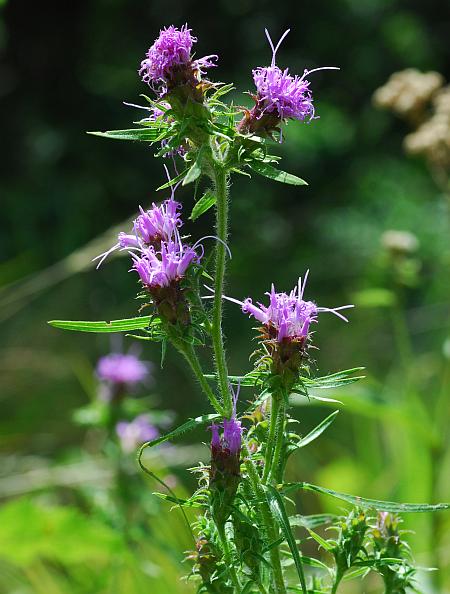Liatris squarrosa (L.) Michx.
Scaly Gayfeather

Native
CC = 6
CW = 5
MOC = 65
© SRTurner
Liatris squarrosa (L.) Michx.Scaly Gayfeather | |
 |
Native CC = 6 CW = 5 MOC = 65 |
© SRTurner |
|
Family - Asteraceae/Eupatorieae Habit - Perennial forb with a globose corm. Stems - Ascending to erect, to 75 cm, pubescent with relatively long, straight, spreading hairs.
Leaves - Alternate, simple, grasslike. Basal and adjacent lower stem leaves sessile to short-petiolate, the blades 7-20 cm long, 2-12 mm wide, linear to narrowly lanceolate or narrowly oblanceolate, the margins usually light, hard, and thickened, sometimes also sparsely hairy, flat, the surfaces pubescent with spreading, straight or curly hairs, green, with 3-5 main veins, grading toward the stem tip to shorter leaves, these mostly sessile, 3-15 cm long, linear.
Inflorescences - Relatively short to more elongate spicate racemes of flowering heads, these loosely spaced (the axis easily visible between heads), sessile or with stalks 1-10 mm long, these with usually 1 basal bract.
Heads - Discoid, with 15-45 florets, the terminal head usually slightly larger than the others. Involucre 11-25 mm long, cup-shaped, with 5-7 weakly unequal, overlapping series of bracts, the outer series usually appearing noticeably longer than the other series, especially on the terminal head. Involucral bracts broadly ovate to oblong-lanceolate, long-tapered to a sharply pointed, abruptly spreading to recurved tip, usually with narrow, slightly thickened, pale margins, these sometimes slightly to strongly purplish-tinged, entire but with relatively dense, spreading hairs, the surface also hairy, the main body appearing flat below the tip.
Flowers - Ray florets absent. Disk corollas 12-14 mm long, the 5 lobes with often dense, short, stiff hairs on the inner (upper) surface. Pappus bristles plumose. Stamens 5, adnate at the middle of the corolla tube. Filaments white, glabrous, 2 mm long. Anthers brown, connate around the style, 3 mm long, mostly included. Style white basally, glabrous, 2 cm long, divided and purple in the apical half, well exserted beyond the corolla.
Fruits - Achenes 4-6 mm long, ribbed, antrorse-pubescent.
Flowering - July - September. Habitat - Glades, ledges and tops of bluffs, upland forest openings, savannas, upland prairies, pastures, fencerows, railroads, roadsides. Origin - Native to the U.S. Lookalikes - Other species of Liatris, particularly L. squarrulosa, L. cylindracea. Other info. - This attractive species can be found across most of Missouri but is apparently absent from the bootheel portion of the state as well as the loess-rich northwest corner of the state. Beyond Missouri it ranges across much of the central and southeastern portion of the continental U.S. The plant is easily recognized as Liatris by the heads of purple discoid flowers and exserted styles. However, plants in the Liatris genus can be challenging to identify to species. This one is characterized by a moderate stature (usually well under 1 m), discrete, well-separated heads, and involucral bracts with spreading tips. Photographs taken at the Sunklands Conservation Area, Shannon County, MO., 7-26-04 (DETenaglia); also at Little Lost Creek Conservation Area, Warren County, MO, 8-25-2011, 7-10-2012, and 7-24-2016; Taum Sauk State Park, Iron County, MO, 7-23-2018, and Twenty-Five Mile Prairie, Polk County, MO, 8-6-2024 (SRTurner); and in St. Louis County, MO, 10-26-2023 (KBildner). |